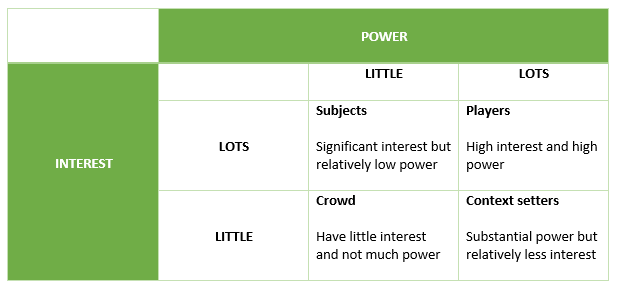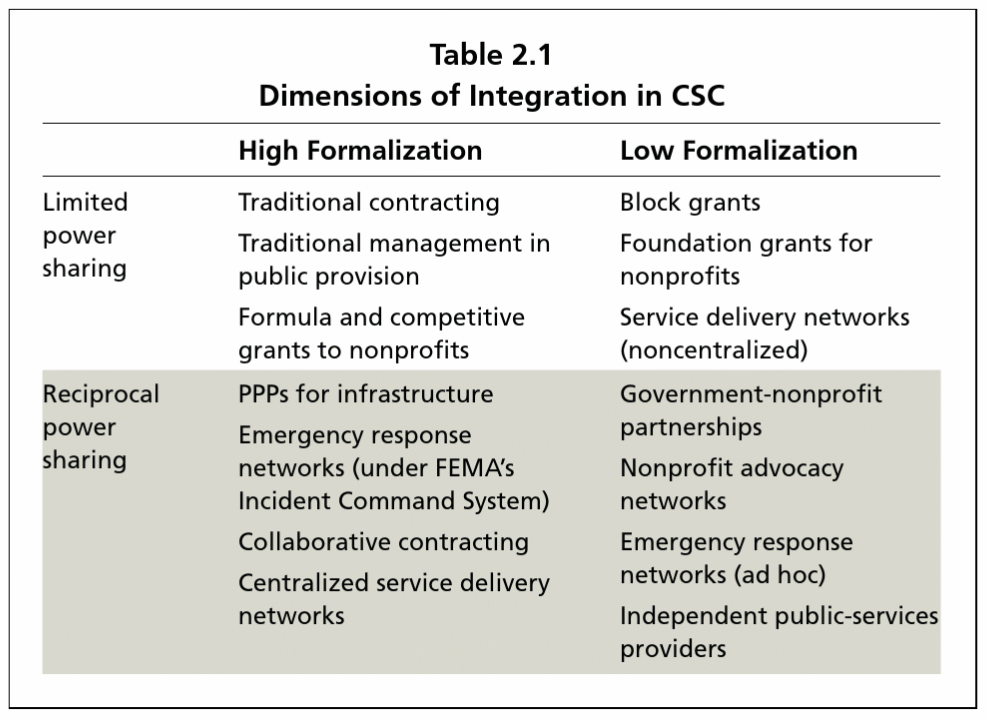TOPIC 2.2: Stakeholder mapping
There are multiple ways to identify and map stakeholders and their relationships within the system you are analysing. Stakeholder mapping can assist when we are seeking to implement changes. Stakeholder maps can identify the sources of support for the change or the sources of resistance to the change. Eden and Ackermann (1998, p122)[1] offer a power and interest grid:

Table 2.2: Stakeholder mapping grid
30 min
For further tools to analyse and manage stakeholder relationships, refer to the following article:
Managing out engages us in cross-sector, cross-boundary, cross-team activities such as partnerships, contracts and networks as we collaborate with stakeholders (individuals and groups) throughout our service systems. Traditionally government has engaged in principal-agent relationships, however as we evolve relationships along the collaborative continuum as shown in Fig 2.1 below, our ‘managing outwards’ work changes. In terms of power redistribution, we may find ourselves engaged in more principal-principal arrangements.
The continuum below reflects the increasing interdependency required as parties work towards true collaboration.

Adapted from Zorich, D., Waibel, G. & Erway, R. (2008) [2]
25 min
Consider the following reading where these different stages of the collaborative process are defined.
Himmelman, A.T. (2002). Collaboration Defined: A Developmental Continuum of Change Strategies. Himmelman Consulting.
There are multiple engagement strategies. The types of engagement tools and techniques in a community engagement toolkit may include:
|
|
THE GOVERNANCE CONSEQUENCES OF CSC
from Forrer, J. J., Edwin, J., & Boyer, E. (2014, p.48).

“As more and more governments engage the private and nonprofit sectors in various forms of CSC, there are very real social, political, and structural challenges that make it much more difficult for the public sector to ensure that the public is well served. Much of this concern has been investigated through the literature on government accountability (Behn 2001 and Lynn 2006) and that of collaborative governance (Forrer et al. 2010).
The more collaborative forms of cross-sector exchange challenge norms of traditional government administration; they also challenge the norms of how public managers should engage the private and nonprofit sectors (Entwistle and Martin 2005). They move out of their reliance on rule-bound governance to an environment that depends on acting outside those guidelines and creating more discretion for and power sharing with the collaborators (Agranoff 2012).
The increased discretion afforded the nongovernmental parties involved in CSC, however, creates a number of potential problems that the public manager must manage.”[3]
10 min
Identify one strategic relationship you are currently managing or are aware of in your place of work. What type of relationship is it? (Partnership, Contract, Network) and what is the power formality nexus?
Recommended
20min
Identify a current problem you are attempting to address at work or a change you need to implement.
- Who are the stakeholders and what are their interests in the problem and working towards a solution?
- Who has the power to stop or support your proposed change?
Draw a rich picture illustrating the problem and the network of interests surrounding it. Remember to represent yourself in the picture.
Note: Identifying stakeholders and their interests is the first step. Analyse their relationships and where and how you can get support. Being aware of the relationship dynamics is the key to managing effective change.
- Eden, C., & Ackerman, F. (1998). Making Strategy: The Journey of Strategic Management. London: Sage. ↵
- Zorich, D., Waibel, G. & Erway, R. (2008). Beyond the Silos of the LAMs: Collaboration Among Libraries, Archive and Museums. OCLC Programs and Research. ↵
- Forrer, J. J., Edwin, J., & Boyer, E. (2014). Governing Cross-Sector Communication. San Francisco CA: Jossey-Bass. ↵

